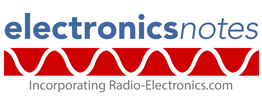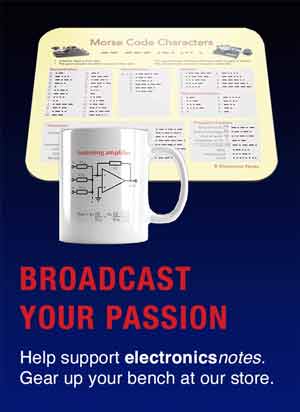The EF50 Thermionic Valve: A Glass Pioneer and Wartime Hero
The EF50 pentode valve / vacuum tube was not only technologically advanced for its time, but also it helped change the course of history, and second to the magnetron, possibly more than any other valve.
History of the Valve / Tube Includes:
History overview
Early discoveries
Fleming's oscillation valve
de Forest's Audion
Development of the basic idea
R-type valve
6L6 valve
EF50 valve
The EF50, while looking very different to many other valves with its red outer (typically) case and its overall shape, but its difference is not only in its looks, but also in its construction and the performance it provide.
The EF50 was born from the burgeoning television industry of the late 1930s, this rather unusual device quickly became an indispensable workhorse during World War II, quietly underpinning the Allied war effort in radar and radio communications.
Its innovative all-glass construction set new standards for performance and reliability, paving the way for future generations of miniature valves.
Video: Britain's SECRET WW2 Electronic Component Lifesaver!
The Pre-War landscape and television's impetus
The late 1930s was a period of intense innovation for electronics technology. One of the major drivers had been radio, but this was beginning to mature and other technologies around it were beginning to be explored.
One area was that of television, which is a story in its own right, but we'll focus on the developments that were forged as a result of its early introduction.
Early television systems, such as those pioneered by the BBC at Alexandra Palace, operated at frequencies far higher than conventional radio. These higher frequencies, particularly in the VHF (Very High Frequency) band, presented significant challenges for valve designers.
Existing valves, with their relatively large electrodes, long connecting wires, and traditional pinched-glass bases, suffered from high inter-electrode capacitance and inductance.
These parasitic elements severely limited their performance at higher frequencies, leading to reduced gain, instability, and poor bandwidth – all critical factors for television Intermediate Frequency (IF) amplifiers.
Manufacturers like the electronics giant, Philips in the Netherlands recognized the urgent need for a new generation of valves specifically designed for these demanding applications.
They needed a valve that could offer high gain, low noise, and stable operation well into the VHF spectrum.
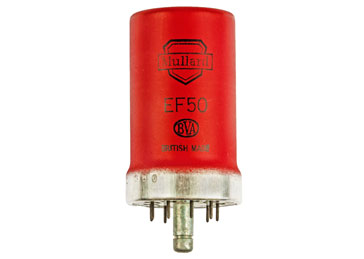
The Philips' all glass design
Philips designed the EF50 to meet the specific need for much higher performance high frequency valves with good performance extending into the VHF region of the radio spectrum.M/p>
One of the issues with te valves of the day was that the base required the connections to come close together
Out of this necessity, Philips developed the EF50 which was completed in 1938 and launched in 1939.

The new valves was revolutionary for several reasons, but primarily for its all-glass construction. Traditional valves used a "pinch" at the bottom where the glass envelope was sealed around the lead-out wires, creating a relatively large, unwieldy base. This design contributed significantly to parasitic capacitances and made automated manufacturing difficult.
The EF50, in contrast, employed a completely new manufacturing technique. The electrode assembly (anode, grids, cathode) was mounted in a complete glass envelope with a glass button base through which the lead-out wires were sealed directly.
This all-glass seal allowed for much shorter, stiffer electrode connections, dramatically reducing inductance and capacitance. The absence of the traditional pinched-glass base also meant a smaller overall valve size and a more robust structure.
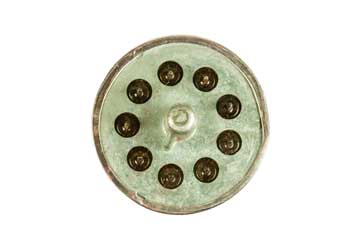
Although the metal can covers the base, the glass envelope and the pins can be seen through the holes in the can.
The valve was designed to plug into an octal-style socket, although it was rather different in looks, and this new base was later standardised as the B8G base.
Technically, the EF50 was a sharp-cutoff pentode. A pentode incorporates three grids (control grid, screen grid, suppressor grid) between the cathode and anode, which significantly improves gain and reduces unwanted grid-to-anode capacitance (Miller effect) compared to triodes or tetrodes.
The "sharp-cutoff" characteristic meant its gain could be quickly and effectively controlled by varying the control grid voltage, making it ideal for the AGC (Automatic Gain Control) circuits essential in television receivers.
EF50 technical attributes
The EF50 was able to provide a significant improvement in performance over the other valves or tubes that were available at the time.
High Transconductance (gm): This meant a small change in grid voltage resulted in a large change in anode current, translating to high amplification.
Low Input and Output Capacitance: Crucial for stable operation at VHF frequencies, allowing for wider bandwidths necessary for TV signals.
Robust Construction: The all-glass envelope made it more resilient to vibration and shock than its predecessors.
Its initial target uses were clear: IF amplification in television receivers. The ability of the EF50 to amplify weak, high-frequency television signals with stability and good bandwidth made it a cornerstone of emerging TV sets across Europe.
However, its civilian career was to be short-lived as it was to be put to more urgent use in other areas before very long.
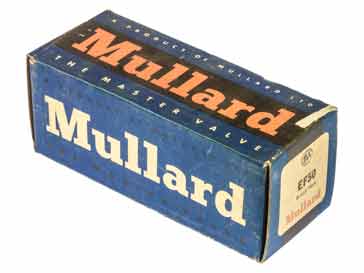
World War II dawns
The dark clouds of World War II gathered over Europe and then actual conflict arose with many countries in Europe being invaded and taken over.
With the likelihood of Britain facing war with Germany, the development of radar became paramount.
Britain was acutely aware of the looming aerial threat, had been secretly developing radar systems since the mid-1930s.
These systems, designed to detect enemy aircraft and later U-boats and surface vessels, operated at high frequencies for te day and this demanded components like the EF50 with much better performance at these frequencies.
The EF50, with its excellent VHF characteristics and robust design, was perfectly poised for this critical role. Suddenly, production lines intended for domestic television sets were repurposed. The humble television valve became a vital military component overnight.
The big problem was that these valves were made by Philips and Philips were based at Eindhoven in Holland.
It because obvious that the Nazis would invade Holland so duplicates of the jigs and machinery were made to ship to Britain.
Then with the Nazi's poised to invade all the machinery was loaded onto trucks to take them to a port to be loaded onto a ship and transported to England.
The trucks were loaded and literally a few hours later The Nazis invaded.
The ship that carried this vital cargo to England was attacked by the Luftwaffe, but fortunately it escaped to land safely in England, where the machinery and 25 00 valves and many bases were quickly transported to the Mullard factory in Blackburn to enable the production to start there.
This was a VERY narrow escape!
The demand for EF50s during the war was immense. Philips' factories in the Netherlands had come under German occupation, so production was rapidly scaled up in the UK , initially by Mullard, but later, EMI, and GEC were given contracts. They were also made in the USA by RCA, Sylvania, and Ken-Rad under license.
Millions of these valves were produced, and the EF50, being versatile and widely produced, became a go-to component. Its standardisation meant that military equipment could be repaired quickly using readily available spares, a critical factor in wartime logistics.
Wartime production and applications
The EF50 found itself at the heart of numerous critical British electronic systems:
Chain Home Radar: Britain's pioneering early warning radar system, crucial during the Battle of Britain. While Chain Home initially used older valves, the EF50 quickly found its way into later iterations and associated equipment due to its superior performance.
Ground Controlled Interception (GCI) Radar: These mobile radar units guided fighter aircraft to intercept enemy bombers, particularly at night. The EF50 was indispensable in their IF stages, providing the necessary gain and bandwidth for accurate targeting.
Airborne Radar (AI Mk. IV, Mk. VIII): Installed in night fighters, these radar sets allowed pilots to locate enemy aircraft in the dark. The cramped, vibrating conditions of an aircraft demanded robust valves, and the EF50 delivered. Its compact size relative to older power valves also made it suitable for airborne use.
Radio Communications: Beyond radar, its high-frequency capabilities made it valuable in various military radio receivers and transceivers, particularly those operating in the VHF bands.
Identification Friend or Foe (IFF) Systems: These transponders, essential for distinguishing Allied aircraft from enemy ones, also relied on high-frequency valves like the EF50 for their receiver and transmitter sections.
Legacy
After the war, the EF50 continued to be used in large quantities. Its well-established production infrastructure and proven performance meant it continued to be used in civilian applications for several years.
As civilian broadcasting was resumed, the EF50 found it was required for its initial application of use in television sets. But it also found many other uses in everything from test and measurement equipment including oscilloscopes and signal generators. The valve was also widely used by radio amateurs as it was so widely available, and many appeared on the surplus markets.
The impact of the EF50 on valve design was huge. Its all-glass construction, with pins sealed directly into a glass base, became the blueprint for the next generation of miniature valves with all glass envelopes like the B7G and B9A bases that dominated the 1950s and 60s.
Valves like the EF91 (6AM6/6BA6) and EF95 (6AK5/6AU6) were direct descendants, further miniaturised but inheriting the core design philosophy of the EF50. The drive for compact, reliable, and high-frequency performance initiated by the EF50 ultimately paved the way for the transistor revolution.
EF50 data
| EF50 Thermionic Valve Datasheet Parameters (Typical / Maximum) | |||
|---|---|---|---|
| Parameter | Symbol | Value | Unit |
| Heater Voltage | Vh | 6.3 | V |
| Heater Current | Ih | 0.3 | A |
| Maximum Anode Voltage | V(max) | 350 | V |
| Maximum Anode Dissipation | Pa(max) | 1.5 | W |
| Maximum Screen Grid Voltage | Vs(max), Vg2(max) | 275 | V |
| Anode Voltage (Typical Operating) | Va | 250 | V |
| Screen Grid Voltage (Typical Operating) | Vs, Vg2 | 250 | V |
| Control Grid Voltage (Typical Operating) | Vg1 | -2 | V |
| Anode Current (Typical Operating) | Ia | 10 | mA |
| Screen Grid Current (Typical Operating) | Is, Ig2 | 3 | mA |
| Anode Resistance | ra | 1.0 | MΩ |
| Mutual Conductance | gm | 6.5 | mA/V |
| EF50 Pin Connections) | |||
|---|---|---|---|
| Pin Number | Function | Description | |
| 1 | Heater | One side of the filament (heater) connection. | |
| 2 | Screen Grid | Grid 2 (g2). | |
| 3 | Anode | The main current collecting electrode (plate). | |
| 4 | Suppressor Grid | Grid 3 (g3). | |
| 5 | Screen | Internal shield connected to the outer metal screening can of the valve. | |
| 6 | Cathode | The electron-emitting electrode. | |
| 7 | Control Grid | Grid 1 (g1), the input electrode that controls the electron flow. | |
| 8 | Screen | Internal shield connected to the outer metal screening can. | |
| 9 | Heater | The other side of the filament (heater) connection. | |
NB: the EF50 uses a B9G valve base.
From a bold step in television technology to an unsung hero of radar and radio communications, the journey EF50 thermionic valve is a compelling narrative of innovation under pressure.
Its revolutionary all-glass construction set a new benchmark for performance at high frequencies and its mass production proved to be a major asset and it was one of the important electronic devices that paved the way to the Allied victory in World War II.
 Written by Ian Poole .
Written by Ian Poole .
Experienced electronics engineer and author.
More History:
Radio history timeline
History of the radio
Ham radio history
Coherer
Crystal radio
Magnetic detector
Spark transmitter
Morse telegraph
Valve / tube history
PN junction diode invention
Transistor
Integrated circuit
Quartz crystals
Classic radios
Mobile telecoms history
Vintage mobile phones
Return to History menu . . .
